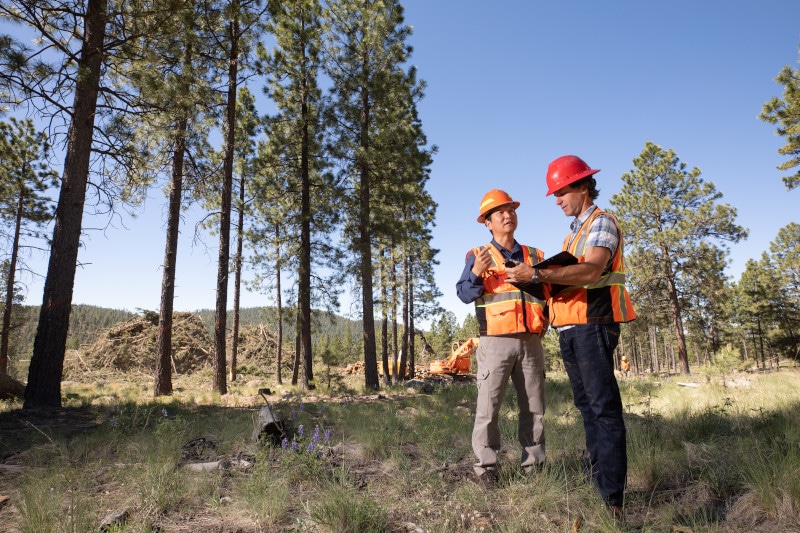As climate change and drought cause increasingly severe wildfires and degrade forest health throughout the Southwest, researchers at Northern Arizona University’s Ecological Restoration Institute (ERI) are working on sustainable solutions that support forest restoration as well as the long-term economic health of the region.
NAU professor Han-Sup Han, ERI director of forest operations and biomass utilization, recently received a $260,000 award from the U.S. Forest Service for a two-year project designed to reduce wildfire risk, develop the wood products market, invest in rural economies and increase forest restoration treatments across Arizona, New Mexico and Colorado. The Wood Innovations Grant is part of a $7.62 million Forest Service investment to advance innovations in wood products that create jobs, revitalize local economies and support sustainable forest land management.
Han says the limited capacity of the forest products industry, supply interruptions and workforce shortages, along with scarce markets for small-diameter wood and biomass, are big barriers to implementing large-scale forest restoration projects. The Forest Service created the Wood Innovations Grant to support efforts to expand the utilization of wood and biomass through the development of “clusters” of forest products businesses.
“Through the Wood Innovations Grant, we are bringing together professionals and experts in the forest products arena to create innovative approaches and strategies,” Han said. “We are looking closely at developing forest products business clusters with multiple companies in one location that can use the many different components of each tree, including the limbs, needles and tops.”
With funding from the new grant, Han is leading the Southwest Ecological Restoration Institutes (SWERI) Wood Innovations and Utilization Team, which is made up of representatives from ERI, the New Mexico Forest and Watershed Restoration Institute at New Mexico Highlands University and the Colorado Forest Restoration Institute at Colorado State University.
“The project’s goal is to create a center of expertise—based on the capabilities of SWERI members—that can support the development of clusters of forest-based enterprises. These clusters will operate synergistically and create markets that are the primary catalysts for restoring forests and grasslands in the Southwest,” he said.
One promising location for a wood business cluster is near Garland Prairie in Williams.
“Forest restoration has a lot of other benefits such as job creation, rural economic development, watershed protection and fire prevention,” Han said. “We believe we can set a good example for the rest of the West to follow.”
A nationally recognized cluster of forest products businesses currently operates in the White Mountains in eastern Arizona. The cluster, which uses small-diameter ponderosa pine trees and all the components of the trees, supports 15,000 acres of annual forest restoration activity on the Apache-Sitgreaves National Forest.
To replicate the structure of the eastern Arizona industry cluster across the Southwest, Han says the Wood Innovations and Utilization Team plans to host education and workshop training events in collaboration with project partners and other industry experts. Conferences and field trips also will be part of the work plan to expand the wood industry, demonstrate advancements in small log processing technology, present information about the latest equipment, showcase emerging markets for forest products like biochar for soil amendment and cross-laminated timber for construction and feature business planning and networking.
“Never has it been so critical to cut trees at a much-increased pace and scale to improve forest health,” said Carmen Austin, climate change specialist with the Energy, Minerals and Natural Resources Department Forestry Division. “We are faced with the effects of climate change and forests that are generally overstocked from a century of fire exclusion.”
In the past, an ongoing obstacle to removing the over-abundance of small-diameter ponderosa pine trees that contribute to massive forest fires has been a lack of uses for the wood and biomass.
“The forest industry in the Southwest region has not been growing because of the challenging economics of processing small-diameter logs. Ponderosa pine is not necessarily an ideal species from a forest products point of view. It’s not a high-value species and takes more effort to produce wood products,” Han said. “But there are some different technologies now and different ideas about how to make good products out of it.”
“Led by the SWERI, we’re correctly recognizing the need not only to restore resiliency to our forest landscapes but the resiliency of our biomass business community,” said Tim Reader, wood products utilization and marketing program specialist at the Colorado State Forest Service. “Developing profitable market-based solutions with industry partners will help increase the capacity and decrease costs of forest restoration across the landscape.”
Han expects outcomes of the Wood Innovations Grant to bolster forest restoration projects in the Southwest, including the Four Forest Restoration Initiative (4FRI). The goal has been to treat (thin and burn) 2.4 million acres across the Mogollon Rim at a rate of 50,000 acres annually. 4FRI officials say they are averaging about a third of their goal each year, treating less than 15,000 acres.
“We have completed more than 800,000 acres of treatments since we started, but the mechanical treatment goals have fallen well short of our goals,” said Henry Provencio, Forest Service 4FRI innovations and efficiencies coordinator.
“Funding from the Wood Innovations program and leadership from NAU complements and expands the capacity and delivery of wood and biomass utilization assistance and market development in southwestern Colorado,” Reader said. “Several forest collaboratives, including our recent Rocky Mountain Restoration Initiative, are in place, and this funding aligns with the group’s consensus-based objectives on our public and private lands.”
“We are a small part of the big picture and we are going to keep trying to restore forests,” Han said. “We have tried in the past, but now we have new strategies to make the restoration process more cost-effective and more knowledge from lessons learned, which we will be applying to the challenges we’ve been dealing with. Our goals are to restore the forests and create economic opportunities.”
Bonnie Stevens and Kerry Bennett
Office of the Vice President for Research




